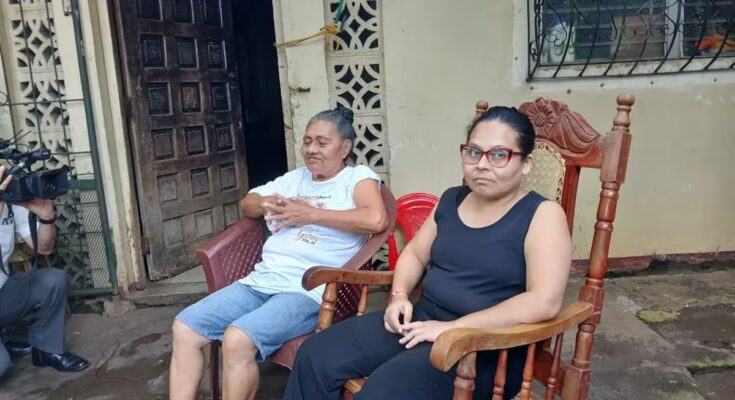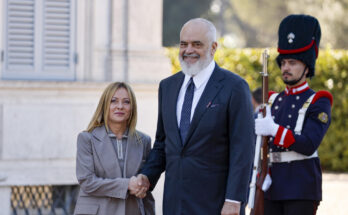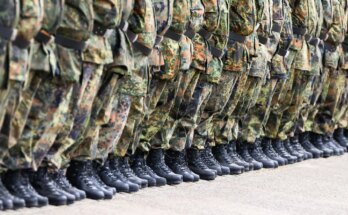Nicaragua’s co-presidents, Daniel Ortega and Rosario Murillo, resorted Tuesday to an old cover-up tactic: freeing and parading political prisoners who had been forcibly disappeared. The move comes on the eve of a crucial decision for the Sandinista regime: the Trump administration will have to decide whether to expel the country from the Dominican Republic-Central America-United States Free Trade Agreement (DR-CAFTA) or impose 100% tariffs, due to systematic human rights violations that are “a burden on US trade,” according to an investigation by the Office of the US Trade Representative.
Throughout the morning, Sandinista propaganda organs showed images of journalist Fabiola Tercero, one year and four months after her arrest, the raid on her home and her disappearance from public view. “Another lie collapses for the traitors of the homeland”, headlined the official media, in an attempt to discredit all those who demanded to know the journalist’s whereabouts.
In accordance with a tactic previously used by the co-presidential regime and classified by human rights organizations as “forced confessions,” Tercero, egged on by pro-government journalists, declared that “for the past few years I have lived at home with my mother in the William Díaz neighborhood, District II of Managua.” Four days earlier, the regime had also quietly released five other political prisoners, including journalist Leo Cárcamo.
In the previous months, the US embassy in Managua had campaigned on behalf of Tercero and Cárcamo, demanding evidence of the life of the Managua regime and disclosure of their whereabouts. Political analysts consulted by EL PAÍS interpret this release and the public display of these individuals as an attempt by the two-headed presidency to once again use political prisoners as bargaining chips for its own benefit. On November 19, the Office of the United States Trade Representative (USTR) will conclude a public consultation phase of its investigation, which will conclude that the regime’s “acts, policies, and practices” are “unconscionable and burden or restrain U.S. commerce,” according to the determination issued under Section 301 of the Trade Act of 1974.
What the USTR will put on the table in the Oval Office are options that represent a lethal blow to the economy of Nicaragua, whose main trading partner is Washington: expulsion from DR-CAFTA, a crucial trade agreement for Nicaragua, and the imposition of 100% tariffs. This is a measure that has always been feared in Managua, but above all by US entrepreneurs in the textile, tobacco and coffee sectors with interests in the Central American country, who have exerted strong pressure in Washington to avoid such a devastating blow, despite the serious violations of human rights in Nicaragua.
“And this is where political prisoners are once again used as bargaining chips,” Salvador Lucio Marenco, human rights lawyer for the Nicaragua Never Again Collective, tells EL PAÍS. “In addition to the deliberations on the free trade agreement, there is another important event: for the first time in a long time, the dictatorship confronted the international community before the United Nations Third Committee, when the Panel of Experts presented its report on crimes against humanity. During that session, Nicaragua’s deputy ambassador expressed the regime’s concern regarding sanctions and economic measures.”
Will the United States fall into the trap again?
This is not the first time that the Ortega-Murillo regime has released political prisoners to ease pressure or obtain concessions from the international community. In this regard, former opposition MP Eliseo Núñez believes that these recent sudden releases are an attempt to start negotiations – or strengthen existing ones – to circumvent Nicaragua’s expulsion from the DR-CAFTA agreement and tariffs.
However, the opposition leader, stripped of citizenship, warns it could also be a Sandinista ploy “to buy time” as he consolidates his relationship with China, following the creation of special economic zones costly to Asian interests. “To allow Chinese companies to export to the United States under the aegis of CAFTA, bypassing sanctions and tariffs,” explains Núñez. “As I said, keeping Nicaragua in CAFTA would be a mistake.”
Juan Carlos Gutiérrez, a researcher and also a private citizen, warns the United States: the release of political prisoners is an old tactic that does not produce any fundamental change, he insists. When the Ortega-Murillo regime gains an advantage, it returns to repression. “What they are doing is managing the terror that they have already spread to a significant part of the population, because these releases serve three purposes at once,” he points out. And he begins to list them: “Reduce the political cost of keeping hundreds of people unjustly imprisoned, reduce the economic expense of keeping them in prison and shift the psychological and material burden onto their families. They release people who are afraid, like Fabiola Tercero; unable to communicate, unemployed and under constant surveillance.”
So far, the latest released political prisoners have refused to speak to anyone, let alone their families, and must report to a police station daily to sign a time sheet. Meanwhile, Nicaragua’s economic future – more than 55% of its trade with the United States – will now be in the hands of President Trump, brokered by Secretary of State Marco Rubio.
Sign up to our weekly newsletter to get more English-language news coverage from EL PAÍS USA Edition


